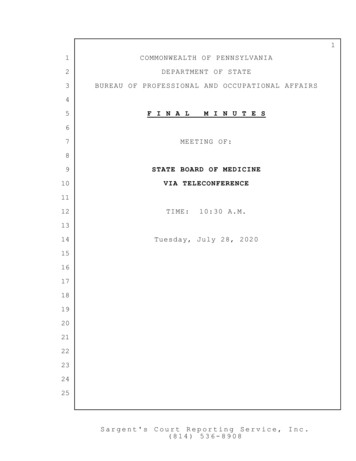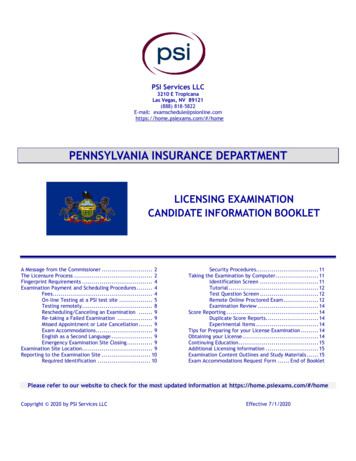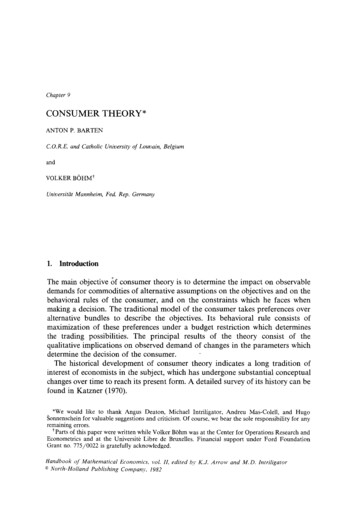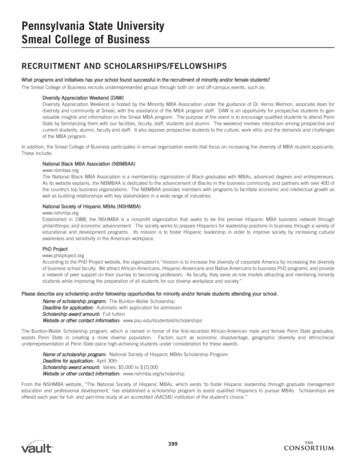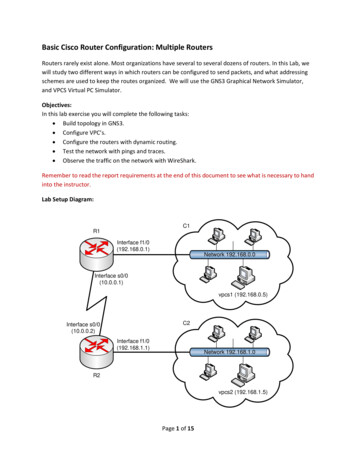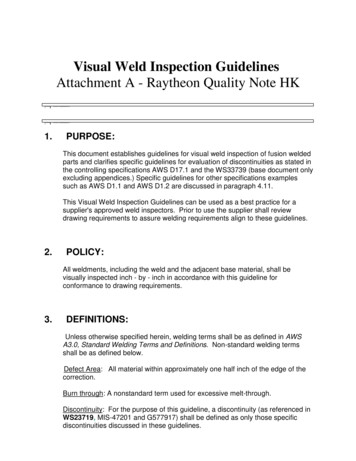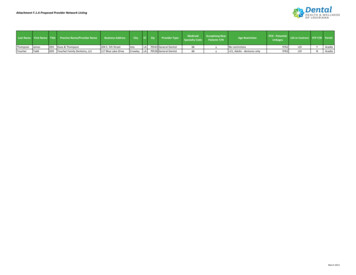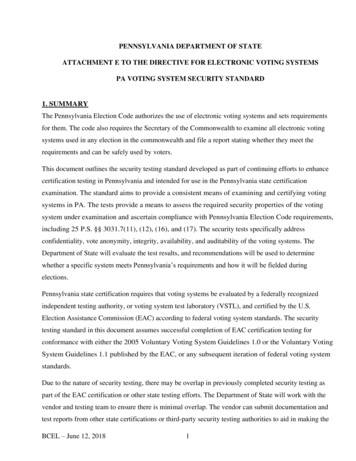
Transcription
PENNSYLVANIA DEPARTMENT OF STATEATTACHMENT E TO THE DIRECTIVE FOR ELECTRONIC VOTING SYSTEMSPA VOTING SYSTEM SECURITY STANDARD1. SUMMARYThe Pennsylvania Election Code authorizes the use of electronic voting systems and sets requirementsfor them. The code also requires the Secretary of the Commonwealth to examine all electronic votingsystems used in any election in the commonwealth and file a report stating whether they meet therequirements and can be safely used by voters.This document outlines the security testing standard developed as part of continuing efforts to enhancecertification testing in Pennsylvania and intended for use in the Pennsylvania state certificationexamination. The standard aims to provide a consistent means of examining and certifying votingsystems in PA. The tests provide a means to assess the required security properties of the votingsystem under examination and ascertain compliance with Pennsylvania Election Code requirements,including 25 P.S. §§ 3031.7(11), (12), (16), and (17). The security tests specifically addressconfidentiality, vote anonymity, integrity, availability, and auditability of the voting systems. TheDepartment of State will evaluate the test results, and recommendations will be used to determinewhether a specific system meets Pennsylvania’s requirements and how it will be fielded duringelections.Pennsylvania state certification requires that voting systems be evaluated by a federally recognizedindependent testing authority, or voting system test laboratory (VSTL), and certified by the U.S.Election Assistance Commission (EAC) according to federal voting system standards. The securitytesting standard in this document assumes successful completion of EAC certification testing forconformance with either the 2005 Voluntary Voting System Guidelines 1.0 or the Voluntary VotingSystem Guidelines 1.1 published by the EAC, or any subsequent iteration of federal voting systemstandards.Due to the nature of security testing, there may be overlap in previously completed security testing aspart of the EAC certification or other state testing efforts. The Department of State will work with thevendor and testing team to ensure there is minimal overlap. The vendor can submit documentation andtest reports from other state certifications or third-party security testing authorities to aid in making theBCEL – June 12, 20181
determination of testing approach. The Department of State, in consultation with the security testingteam, can select some or all of the tests from the test standard. The selection of the tests to be performedwill be based on the documentation of previous testing submitted as part of the request for PAcertification examination.The test specifications that follow cover documentation review, design, software security, networkcapabilities, audit logging, physical security and penetration testing.2. ASSUMPTIONS1) No components of the voting system shall be connected to any modem or network interface,including the Internet, at any time, except in a standalone wired local area networkconfiguration in which all connected devices are certified voting system components.Transmission of unofficial results can be accomplished by writing results to media, andmoving the media to a different computer that may be connected to a network.2) All voting systems purchased on or after February 9, 2018 in PA must be of the type thatemploys a voter-verifiable paper ballot or a voter-verifiable paper record of the votes cast bya voter.3. SCOPE OF THIS DOCUMENTThe standard and tests suggested in this document are applicable only for Security Testing of votingsystems. The public examination and functional test protocol are not part of this standard.4. TEST SPECIFICATIONS4.1 Documentation Review1. Confirm that the voting system documentation includes physical securityrecommendations and polices regarding physical access to the devices andrecommendations and guidance for personnel security, locks, security seals and othertamper evident mechanisms.2. Confirm that the voting system vendor/manufacturer identifies published, reviewed, andindustry-accepted design methodologies, coding conventions, and quality assurance testingstandards. The published standards must allow the testing team to verify compliance.3. Confirm that the voting machine vendor has shared the following with Department ofState. Review the submitted documentation to evaluate the overall security posture of theBCEL – June 12, 20182
system and the vendor’s approach to voting system security.a. Full copy of the Technical Data Packageb. System security architecture and network/communication capabilitiesc. System configuration and hardening instructionsd. Recommended security practicese. Risk analysis/Vulnerability assessmentf. SCAP (Security Content Automation Protocol) Checklistg. Reported field issues/anomaliesh. VSTL deficiency reports supplied to the vendor during EAC campaigni. Penetration testing reports on voting system conducted inhouse or by a third partyj. Third party or in-house organization security assessment/audit reports and/ororganizational IT policies. Documentation on network/communicationcapabilities of the system and how the system can be configured disabling networkfunctionalities if needed.k. Any additional relevant information that demonstrates the voting system security(vendor can submit any additional relevant documentation, or the Department canrequest any specific information that they believe is necessary for testing).4. Evaluate how the security features described in the documentation align or comply withapplicable Commonwealth IT policies. The applicability and compliance must beevaluated by the examiner or testing team and discussed with Department staff. TheDepartment must provide copies of applicable IT policies for evaluation.5. Confirm that the vendor documentation includes explanation of any failover mechanismsincluded in the system and how availability is maintained when a failover happens.6. Confirm that the voting system documentation includes an explanation of how theimplemented controls work together to detect, prevent and respond to any datainconsistency or compromise.7. Confirm that vendor documentation details methods and measures taken to preventunauthorized access to sensitive information. The tests must include, but not be limited toevaluation of the following components of the voting system: vote data,username/passwords, audit log information, physical ballot records, external drives, andsystem hardware, software, operating system etc.BCEL – June 12, 20183
8. Confirm that the voting system vendor has documented suggestions for specializedtraining for election officials to ensure data is securely maintained.9. Confirm that the voting system vendor has suggestions and/or documented processesdetailing best practices for installation, secure configuration and management of data.10. Verify that the voting system vendor documentation includes processes associated with thetransport of system media, including but not limited to: USB flash drives, CF cards, andpaper ballots.11. Verify that the vendor documentation includes processes associated with restricting thetransport of system media to authorized personnel only.12. Confirm that the vendor documentation includes an explanation of system event loggingcapabilities, error code meanings and/or explanation with suggested corrective action, andmethods on how to export logs for safekeeping and analysis.13. Confirm that the vendor documentation includes details about the system adherence to anyindustry accepted Common Data Formats.14. Confirm that the vendor can provide information on decommissioning and disposalprocess to any county purchasing the voting system with a copy to the Department. Thevendor must also agree to adhere to any standards on decommissioning and disposalpublished by the county or Department.Note: The documentation review must evaluate the documentation for accuracy, clarity andcompleteness, and the test results must identify any shortcomings to allow additionaldocumentation and/or process controls that the voting system vendor, Department, and countyelection officials can undertake for safe and secure elections.4.2 Design1. Confirm the system design demonstrates it can maintain consistency, accuracy, andtrustworthiness of data during Election processes. (The testing team must use theirexpertise and refer to best practices to evaluate robustness of the system design.)2. Confirm that the voting system designa) is geared towards reducing attack surfaces and demonstrates the rationale forincluding every individual component and feature.b) provides multiple controls whenever possible to ensure that the system works asexpected and any deviations can be detected.BCEL – June 12, 20184
c) provides the ability for election officials to submit test ballots in order to verify theend-to-end integrity of the voting systemd) provides a mechanism to detect problems and allows election officials to verify theelection outcome in a manner transparent to everyone.3. Confirm that the voting system components provide security access controls that limit anddetect access to critical system components to guard against the loss of system integrity,availability, confidentiality, and accountability.4. Confirm that the voting system provides an alternate mode of operation and data recoveryin the event of any component failure (hardware or software) that provides the samefunctionality of a conventional electronic voting system without losing a single vote andproviding a complete audit trail of the failure events and the recovery action as applicable.5. Confirm that the voting system includes methods to help facilitate the opening and closingof polls enforcing the execution of steps in proper sequence if more than one step isrequired.6. Confirm that the voting system design has appropriate checks and balances orcontrols todetect and avoid any unauthorized data access and modification.7. Confirm that the voting system design has appropriate controls to reduce the probability ofhuman errors duringa) pre-voting steps like ballot preparation, election programming, ballotinstallation, logic and accuracy testing, poll opening, verification of thecentral count scanner etc.b) post-voting steps like close of polls, tabulation, producing reports, postelection maintenance and storagec) voting process (The voting system must ensure that the voter is guidedappropriately through the process with proper completion signal.)8. Confirm that the voting system provides a mechanism for the voter to validate the contentsof the ballot before it is cast irrespective of the mechanism used for casting the vote. Thesystem must support a voter verified paper ballot or voter verifiable paper record whichcan be used by election officials to verify the election results.9. Confirm that any notifications, instructions, warnings, and screen display provided by thevoting system does not compromise the confidentiality or the privacy of the ballot or voterin anyway.BCEL – June 12, 20185
Note: The validations required can be done either by analysis of documentation/test reportsand/or by executing tests if needed. The results must provide the testing team’s opinion on theoverall robustness of the system design. The testing team shall also document any designenhancements and process controls that will aid in reducing the identified shortcomings.4.3 Software SecuritySoftware1. Confirm that the voting system software and firmware are protected from tampering. Thesystem must allow modification to software/firmware only using the vendor documentedinstallation instructions.2. Confirm that the voting system is protected against execution of software that is notconsidered part of the voting system. The testing team/examiner can determine appropriatetests to evaluate kiosk mode operation, whitelisting, malware protection, protection fromunauthorized boot devices and other external devices, secure configuration/hardening,authenticated updates, port access, and root access. Additional tests may also be conductedas they are deemed necessary.3. Confirm that the voting system meets secure configuration recommendations based onbest practices and standards set by a recognized standard setting body.Access Control1. Confirm that the voting system provides robust access control implemented to preventunauthorized access to the system. The system must follow standards set by a recognizedstandard setting body (e.g. NIST, EAC) and industry best practices.2. Confirm that system can authorize actors with minimum necessary access to perform therequired functions. This shall be reviewed for personnel, devices, software, and firmware.3. Critical operations must have enhanced access control and protection. Critical operationincludes, but is not limited to: software and firmware updates, system configuration, resulttabulation and reporting, open/close of polls, adding users/configuring passwords,exporting logs, etc.4. The voting system configuration must enforce best practices in password managementsuch as enforcing default password change, account lockout, minimum passwordcomplexity, etc.BCEL – June 12, 20186
Encryption1. Confirm confidentiality of the data is maintained during transmission of sensitive datathrough the use of encryption.2. Confirm any data at rest cannot be modified by unauthorized actors. The tests mustevaluate access control, encryption, physical security, and chain of custody, and ensurethat layers of security exist to prevent unauthorized access to and/or modification of data.3. Confirm the system cannot transmit non-encrypted and non-authenticated data. The testmust include any network transmissions and any transmissions via physical media. Thetesting team must evaluate the entire data life cycle starting with election preparation untilcanvassing.4. Confirm the system uses encryption and cryptographic standards set by recognizedstandard setting body (NIST, EAC) and industry wide best practices.Note: Testing can involve documentation review, test case execution, review and analysis ofprevious security testing reports by other federal or state government agencies or designees orthird-party security testing organizations. The testing team may evaluate the reports and decideon a testing approach. The tests must consider every individual component of the voting system aswell as the system as a whole. The results must provide details of the test cases, test results andany shortcomings identified.4.4 Network1. Confirm when voting system election management software (EMS) includes networkcapabilities, it is for a closed network, only.2. Confirm the voting system uses air-gapped computer networks, disconnected storagedevices, or hard copy ballots for tabulation and/or results compilation.3. Confirm the voting system provides the capability for voters to continue casting ballots inthe event of a failure of any network functionality.4. Confirm the voting system does not allow a component that is not part of the votingsystem to be connected to the local closed wired network, if used.5. Confirm the system updates and/or install do not involve any connections to insecurenetworks. The install and/or update must happen via secure physical media or air-gappednetworks.6. Confirm the only enabled physical ports and network capabilities of the voting system arethose necessary for proper functioning of the system. The test must also ensure that theBCEL – June 12, 20187
system default configuration adheres to what was reported in the documentation andcannot be tampered with.4.5 Audit Logging1. Confirm that the voting system maintains a secure date/time stamped permanent record ofsystem events and audit data. Data will be used for auditing and investigating fraudulent ormalicious activity. System logging cannot be disabled.2. Confirm the voting system’s real-time audit record provides operators/officials continuousupdates on machine status.3. Confirm the audit log records any attempts to connect to the system and any furtheractions performed. Even with connectivity disabled there may be situations where portsare left open, an intruder attempts to enable disabled ports, etc.4. Confirm the voting system log does not enable identification of an individual voter fromthe logs. The log must prohibit associating the voter’s identity with the voter’s ballot.5. Confirm the system allows for printing, exporting, and saving of the logs in a humanreadable format. The export of and access to logs must be authenticated. Evaluate logprocessing capabilities like combining and filtering etc. to ascertain capability to accessthe specific information to be audited.6. Confirm the integrity of any log files, log file exports or reports by determining that theycannot be altered or tampered with.7. Confirm the voting system implements appropriate checks and balances to ensure that thelogs are exported and saved before the system is prepared for a new election.8. Confirm the event logs have specific identification information to ensure that eachdevice’s logs are identifiable. If the system allows logs for multiple elections to be saved,election logs must also be easily identifiable without any ambiguity.Note: Testing must involve a thorough evaluation of system audit logging capabilities, and theresults must include the testing team’s evaluation of the system audit logging capabilities inreference to identifying operational problems and fraudulent activity.4.6 Physical Security1. Confirm the voting system physical security recommendations suggested in themanufacturer documentation can be implemented for fielded systems and provide therequired security.2. The system must not have any unprotected physical access points. The test must evaluateBCEL – June 12, 20188
every physical access point and evaluate the strength of the protection mechanism.Note: Testing must identify every possible access point to the system and ensure that it isappropriately protected. The test results must document every access point, location of the accesspoint, vulnerability, and how well the physical security recommendations provide system security.4.7 Guidelines for Penetration TestingPenetration Testing: Penetration testing is an attempt to bypass or break the security of a system or adevice. Penetration testing is conducted without the confines of a pre-determined test suite. It instead reliesheavily on the experience and expertise of the team members, their knowledge of the system, itscomponent devices and associated vulnerabilities, and their ability to exploit those vulnerabilities.The scope of penetration testing includes but is not limited to the following:1. Voting system security;2. Voting system physical security while voting devices are:A. In storage;B. Being configured;C. Being transported; andD. Being used.3. Voting system use proceduresThe focus of penetration testing is to seek out and exploit vulnerabilities in the voting system that mightbe used to change the outcome of an election, interfere with voters’ ability to cast ballots and have theirvotes counted accurately, or compromise the secrecy of vote.The test must evaluate whether the voting system under examination possesses the securityproperties to be successfully used in Pennsylvania. The test results must allow the Department ofState to assess the system security posture and to determine best practices while in use forelections. The purpose of the testing is for the testing team to consider the system being tested asan official election environment and ensure that the physical and logical controls in place cannotbe exploited to adversely affect the election. The Department also aims to use the results from thetest to identify conditions and/or recommendations to be specified in the Secretary’s approvalreport to mitigate any risks identified.BCEL – June 12, 20189
Pen
evaluated by the examiner or testing team and discussed with Department staff. The Department must provide copies of applicable IT policies for evaluation. 5. Confirm that the vendor documentation includes explanation of any failover mechanisms . account lockout, minimum password .

